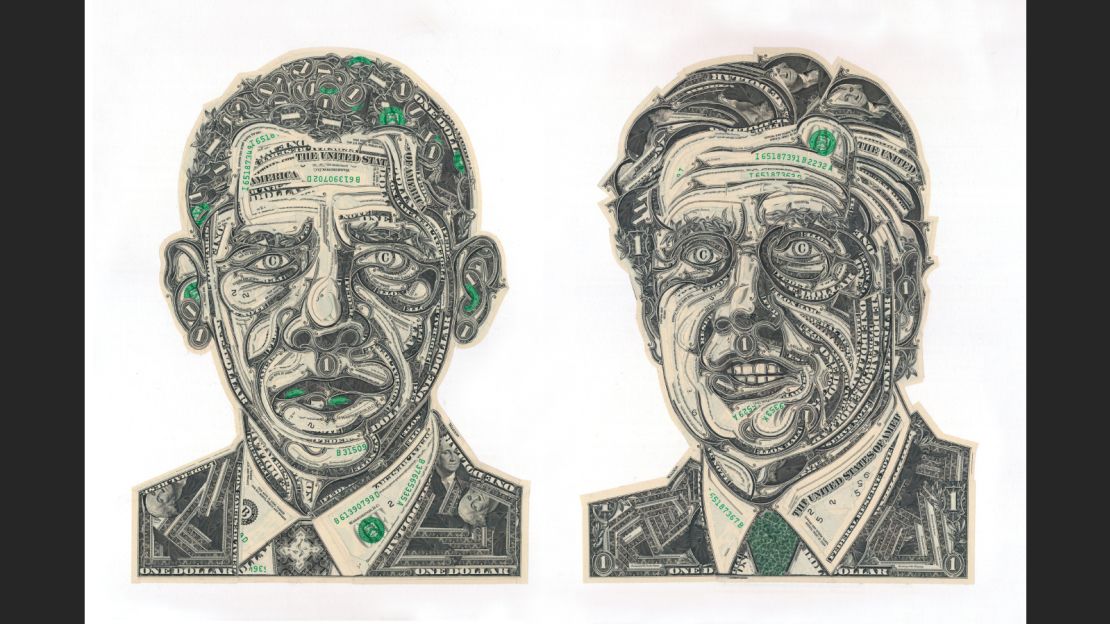Story highlights
American artist Mark Wagner crafts beautiful collages out of U.S. dollar bills
He is known for his political portraits, as well as his fantastical creatures and garden scenes
Money may well have made many a political career but one American artist has now forged his own success crafting politicians themselves out of cold hard cash.
Meticulously handcrafted using small pieces of money – mostly U.S. one dollar bills – Mark Wagner’s currency collages reconfigure the familiar green and black paper into mythical creatures, fantastical garden scenes and US politicians past and present.
“The dollar bill is publicly valued, and I like making it privately valuable – or to reflect how rich the person is that I’m depicting.” says Wagner. “A lot of American figures really are made by the U.S. currency.”
Common denominator
Originally a printer and specialist book binder who has long dabbled in collage, Wagner first started cutting up dollar bills as material for his art in 1999 after he went looking for the most “common” paper he could find to use for one particular piece.
He soon came to realize the versatility money gave him as a medium, as well as the possibilities to explore what money means to people and the essential part it plays in everyone’s life.
“Money means different things to different people, but it’s a subject that everyone is ready to comment on. But when you ask them ‘what is money?’, most people can’t give a good answer and I dress those unknowns into my work,” says Wagner.
Although he uses other types of paper, money has now been Wagner’s primary artistic medium for the last decade and a half, with its texture and multifaceted designs translating well to his unique mosaic style.

“My favorite part – it’s so tiny – Washington’s right lapel. It doesn’t mean anything, his right lapel is dark next to a white line but if you get 1,000 of them and glue them together it makes a nice texture and I hadn’t considered art like that before,” he explains.
Public wealth
His first works were portraits of people – a style he says appeals to him because he likes making a publicly valued asset reflect someone’s private wealth – and he has since expanded his work to include intricately composed scenes of mythological lands and creatures, famous landmarks and statement billboards.
Each collage is created using small pieces of deconstructed bills, carefully glued into place using a brush, and Wagner uses every single part of the bill, whether it be for Abraham Lincoln’s nose, Barack Obama’s ears or for decorative framing around the edge.
“Donald Trump’s eyebrows, they’re very leafy and those same leaves can become a hedge, and something like a hedge has a metaphoric interest to me. It’s a nice looking plant, but it also separates one neighbor from another neighbor,” adds Wagner.
The artist doesn’t normally track how many bills he uses to create a collage, but says he did do a full accounting of the money used for one 17 foot tall collage he created of the Statue of Liberty – which took 1,121 one dollar bills and 81,895 individual scraps of those bills.
This may sound expensive, but Wagner is extremely careful with his money, painstakingly positioning each small piece of money so it doesn’t overlap too much, which makes his currency a cheaper artistic material than oil paint. The egalitarian nature of the bills also appeal to him, which he translates into the way its sold through posters, prints and other renderings.
“Products, t-shirts, catalogs, and calendars, I like that stuff. The rich people who buy fine art, I love them, they give me a chance, but I like that mere mortals can enjoy it as well – I couldn’t afford to buy my own art work,” he explains.
Legal tender
Wagner has worked with other types of U.S. dollar bills and foreign currencies, and while he says he loves the colors and variety they offer, most of his work is now done with the one dollar bill because of its versatility and abundance.
“I stumbled onto a niche benefit using the one dollar bill,” he says. “Also, the one dollar is not precious, and because I can get more, I I have an infinite supply and don’t get distracted with other possibilities.”
He adds that as it’s the only U.S. currency that hasn’t been redesigned since it was finalized in 1963, it has also kept its “baroque elements” and that the president on it – George Washington, as painted by Gilbert Stuart – is the only one that hasn’t been airbrushed.
“We know from drawings that Abraham Lincoln was ugly but you see him on the five-dollar bill and he looks like Kevin Costner, it looks like a rendering,” he says.
And although cutting up U.S. tender is technically illegal, Wagner says he has never had any problems with law enforcement.
The U.S. Federal Reserve itself recently acquired some of his now highly-collectible art while the National Portrait Gallery, which is part of the Smithsonian Institution, once displayed a piece of his just three blocks from the Federal Bureau of Investigation (FBI) headquarters.
A solo exhibition of Wagner’s political portraits and other work, titled MY NAME IS MARK WAGNER, AND I APPROVE OF THIS MESSAGE, runs from September 8 to October 15 at Pavel Zoubok Gallery, 531 West 26th Street, New York. More of his work can be found on his website.
CNN’s Stephy Chung contributed to this report.

























